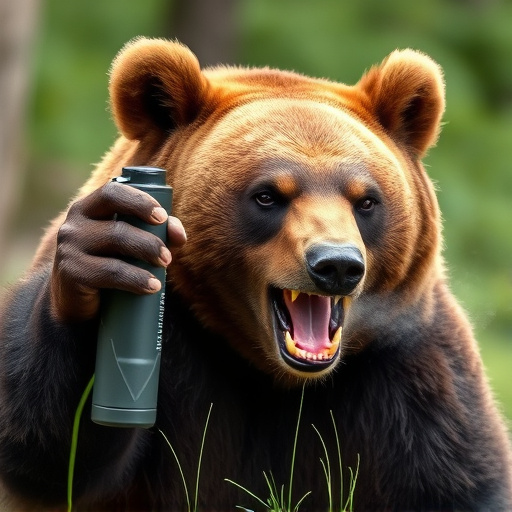Grizzlies pose a threat to humans in wilderness areas due to their exceptional sense of smell and agility. Bear spray, containing capsaicin (15-20% active ingredient percentage), acts as a defense mechanism by irritating bears for escape. Proper usage involves aiming at the bear's face and eyes for maximum effectiveness. Understanding the active ingredient percentage is crucial when choosing bear spray (2% to 4% concentration) for safety in wild territories inhabited by grizzlies, enabling informed decisions and robust defense against potential encounters.
In the vast wilderness, encountering a grizzly bear can be a terrifying prospect. Understanding their behavior and learning effective defense strategies is crucial for adventurers seeking to navigate these wild lands safely. This article explores two key aspects: the allure of human food sources for bears and the power of bear spray, delving into the science behind its active ingredient percentage for maximum effectiveness. We also uncover essential safety tactics beyond bear spray to enhance your wilderness survival skills.
- Understanding Grizzly Bear Behavior and Their Attraction to Humans
- The Science Behind Bear Spray: Active Ingredient Percentage and Effectiveness
- Strategies for Safety in Wilderness: Beyond Bear Spray
Understanding Grizzly Bear Behavior and Their Attraction to Humans
Grizzly bears, known for their immense strength and agility, are powerful animals that can pose a significant threat to humans in the wilderness. Understanding their behavior is crucial when navigating bear country. Grizzlies are primarily omnivores, with a diet consisting of plants, insects, small mammals, and occasionally larger prey. They have an exceptional sense of smell, which makes them highly attracted to human food sources and waste. This attraction can lead to aggressive encounters if bears associate humans with easy meals.
Bear spray, a popular defense mechanism, contains capsaicin, the active ingredient found in chili peppers. This irritant can create a barrier between you and the bear, allowing for an escape. The effectiveness of bear spray relies on proper usage; it’s recommended to aim for the bear’s face and eyes, as these areas are sensitive to capsaicin. With a clear understanding of bear behavior and the right tools, such as bear spray with a high active ingredient percentage (typically 15-20%), hikers and outdoor enthusiasts can minimize risks when facing potential grizzly bear encounters.
The Science Behind Bear Spray: Active Ingredient Percentage and Effectiveness
Bear spray, a popular defense mechanism against aggressive bears, operates on the principle of delivering capsaicin, the active ingredient found in chili peppers, directly into the bear’s eyes and respiratory system. The effectiveness of bear spray lies in its concentration; typically, products range from 2% to 4% capsaicin. This percentage determines how potent the spray is, with higher concentrations offering more protection. Studies show that when used correctly, bear spray can create a critical irritant, temporarily disorienting the bear and providing valuable time for escape or retreat.
The 2% to 4% range is chosen based on balancing effectiveness and safety. Lower concentrations might not induce the desired response, while significantly higher ones could pose risks to users. Moreover, the spray’s aerosol design ensures that capsaicin is evenly distributed, maximizing its impact. This science-backed approach to bear defense underscores the importance of understanding product specifications, including active ingredient percentage, when venturing into wild territories inhabited by grizzly bears.
Strategies for Safety in Wilderness: Beyond Bear Spray
In the face of potential encounters with charging grizzly bears, understanding bear behavior and employing effective strategies are paramount. While bear spray remains a crucial tool, with active ingredient percentages varying for optimal effectiveness, it’s just one piece of the safety puzzle in the wilderness. Beyond bear spray, practicing awareness, making noise to deter bears, and knowing how to respond during an attack are essential skills to master. Combining these measures can significantly reduce risks when adventuring in grizzly bear country.
